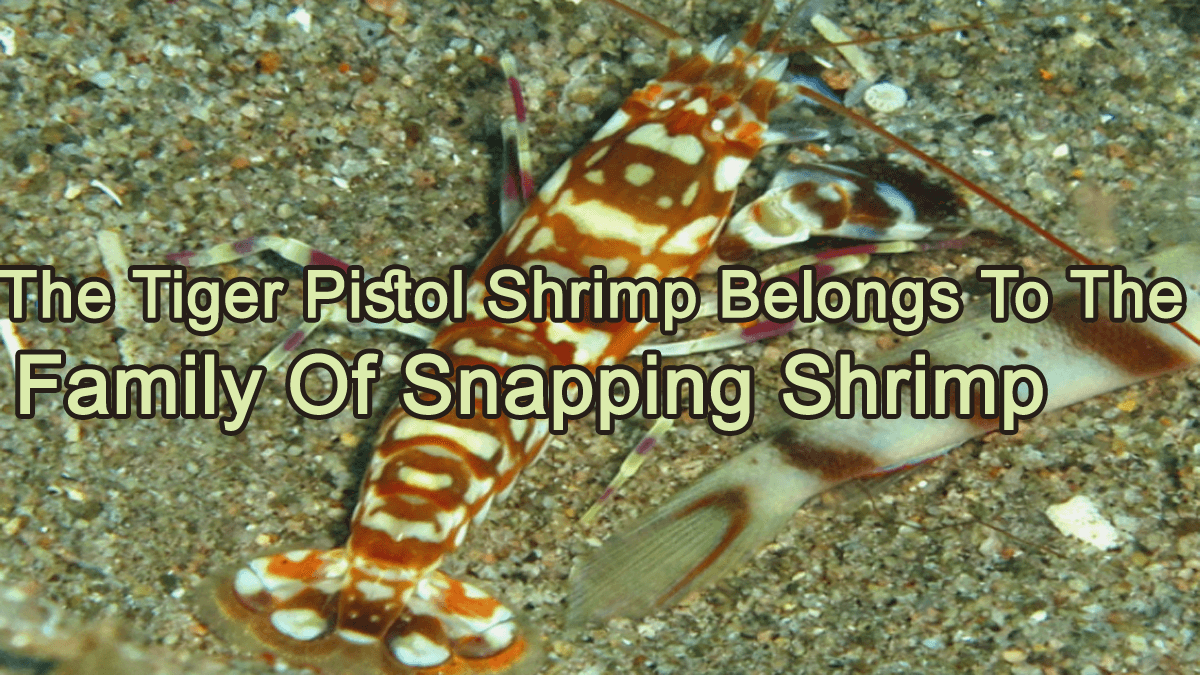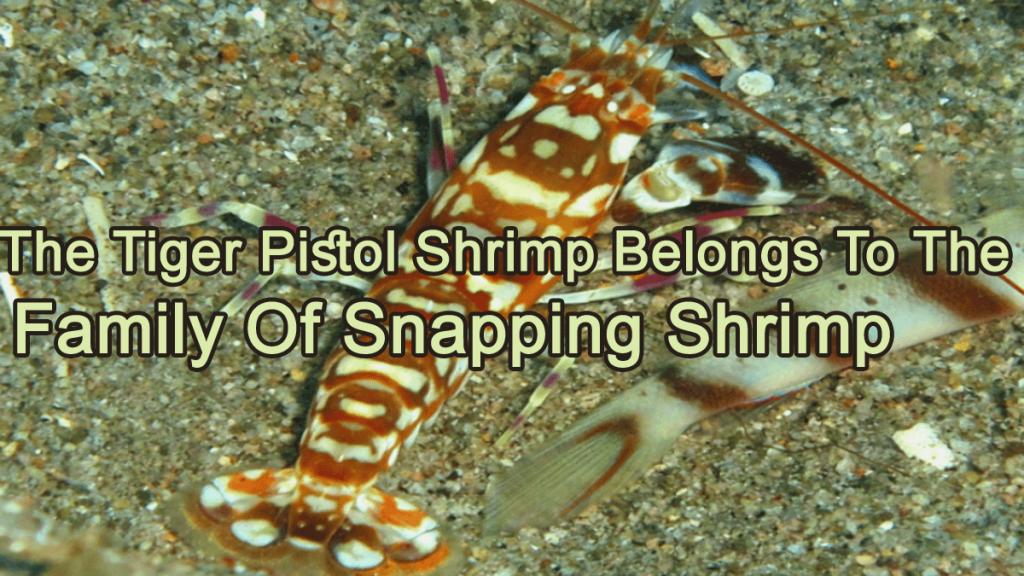The Tiger Pistol Shrimp Belongs To The Family Of Snapping Shrimp

The tiger pistol shrimp (Alpheus Bellulus) is a snapping shrimp that belongs to the Alpheus Bellulus family.
The tiger pistol shrimp is a small marine shrimp that has a symbiotic association with various Gobi species, including the Watchman Gobi, Orange Spot Gobi, and Yasa Hashe Gobi. Just like crabs, it has chelipeds, which serve as an excellent weapon for this species.

Tiger Pistol Shrimp
The body of the tiger pistol shrimp is thick and glossy, with a yellowish-white or bland yellow backdrop. The symmetrical body patterns on the cephalothorax, abdomen, and tail of the pistol shrimp range in hue from light brown to brownish-purple to brownish-orange. Its legs are body-like colors and covered with short bristles.
Scientific Name: Alpheus bellulus
Scientific classification:
Kingdom: Animalia Phylum: Arthropoda Subphylum: Crustacea Class: Malacostraca Order: Decapoda Family: Alpheidae Genus: Alpheus Species: A. bellulus
Tiger Pistol Shrimp Interesting Facts
Pistol shrimp are blind. They mostly live on oyster reefs in the Indo-West Pacific, coral reefs, and submerged seagrass flats, among other places. They can be found in both fresh and salty waters. Pistol shrimps get their name from the sound their claws make, which is louder than a gunshot.
Here you can find the incredible Pistol Shrimp facts that will help to know about pistol shrimp better. Let’s start travel the depths of oceans and learn incredibly interesting Pistol Shrimp facts.
1. What kind of behavior does the Tiger pistol shrimp have
The pistol shrimp dig shelters for themselves and the guppies who accompany them. Sometimes real galleries are formed, with many entrances and exits. They spend a lot of time digging, coordinating the pond floor, and maintaining the burrow. They also frequently dig into the ground in search of food.
They are very shy and secretive, however; they are extremely ever vivacious and able to move at high speed. Indeed, they use these qualities when they rush to their shelter in the slightest danger.
This is due to the fact that they are almost blind. So distrust is an indispensable rule for survival! This behavior is mitigated by the presence of a symbiotic Goby.
2. Where Do Tiger Pistol Shrimp Live
The Pistol shrimp is commonly lived in coral reefs, oysters, surface seaweed, and coral reefs, and is known to dig burrows. In temperate and tropical marine and coastal environments, the majority of the Pistol Shrimp genera can be found. Potamalpheops are the only genus that can be found in freshwater caves, whereas Betaeus prefers cold oceans.
3. Tiger Pistol Shrimp Size
Pistol Shrimp has an unusual physical appearance. This shrimp has a large claw that is disproportionately disproportionate There is no guarantee that the claw will appear on a given arm. It can be present on both the left and right arms.
4.Tiger Pistol Shrimp Lifespan
The pistol shrimps can survive up to 5 years in the free water. While growing in the aquarium, the life span ranges of this species are reduced 2-3 years.
5. Tiger Pistol Shrimp Create a Loud Sound Using A Bubble
Its name “pistol” comes from the loud applause she makes with her enormous claws. Someone can hear easily this noise. The shrimp use it to create a shock wave that can stun its prey.
You can hear the explosion of their bubble from far away. Distant pistol shrimps also create bubble bursts to communicate with each other.
- Sea Bunny Slug Facts & Cute Secrets: Discover the Tiny Ocean Creatures That Look Like Fluffy Rabbits
- World Whale Day 2024: Celebrating These Magnificent Creatures
- Celebrating National Polar Bear Day 2024: Raising Awareness for the Arctic Icon
6. Unusual Relationship Between Tiger Pistol Shrimp And Goby Fish
The symbiotic relationship between tiger pistol shrimp and sentinel shrimp is that they share a tunnel dug by shrimp.
Shrimps don’t have very good eyesight, so gobies keep an eye out for predators for both. When a predator comes, the goby advises the shrimp to adopt a specific tail movement and hide in the tunnel that the shrimp has made. Shrimp and guppies usually share food besides their living quarters.
If shrimp and guppies leave the burrow, they stay in close contact with each other.
7. Tiger Pistol Shrimp Decibels
The Pistol Shrimp opens and closes the hammer portion while hunting, letting it to snap into the other portion. This release is quick and results in a powerful low-pressure cavity bubble.
The sound produced by the bubble burst is 218 decibels louder than a gunshot!
8. How Do Pistol Shrimp Hunt
Pistol shrimps hide in their bur. Gobi fish often tell them about hunting nearby. To find them, the shrimp close their enormous claws and jerk off. Shock waves as the victim faints. Then, the pistol shrimp takes their burrow for food.
You Can Read:
Gigantic Coconut Crab– the biggest land crab worldwide
Impressive Facts About Blue Glaucus
At a glance:
Common Name: Tiger pistol shrimp
Origin: Indian Ocean-Pacific Ocean
Natural Habitat: On sandy and muddy areas of coral reefs (from 1 to 20 m/3.3-66 feet deep)
Parameters: T°: 24 to 26°C (75 to 79°F)
Group: Alpheidae
Size: 4 to 5cm / 1.6 to 2″ (without antennas)
Longevity: 5 years
Living zone: Depth
Symbiotic relationship: Goby Fish
However,
I hope you have gotten a clear idea about The tiger pistol shrimp. If you want to Tiger pistol shrimp as a pet, then you need to know about its symbiotic relationship with some Gobi species.
To successfully maintain this pairing in an aquarium, it is important to provide the right environment. There must be a deep layer of sand in a coral reef or fish tank only, especially one that contains sand pieces and debris of various sizes for the pistol shrimp to build their burrow.
Because they can develop protective in their tunnel, it’s preferable to keep a pair with peaceful partners in the tank and just one pair per tank.
Pistol shrimp can be fed with soaked pellets and gobies to small foods such as prawn Mysis. This odd couple may be observed and enjoyed in any home marine aquarium with the correct setting and care.
If you have any questions about Tiger pistol shrimp facts, then feel free to comment me from the bellow.Thanks





